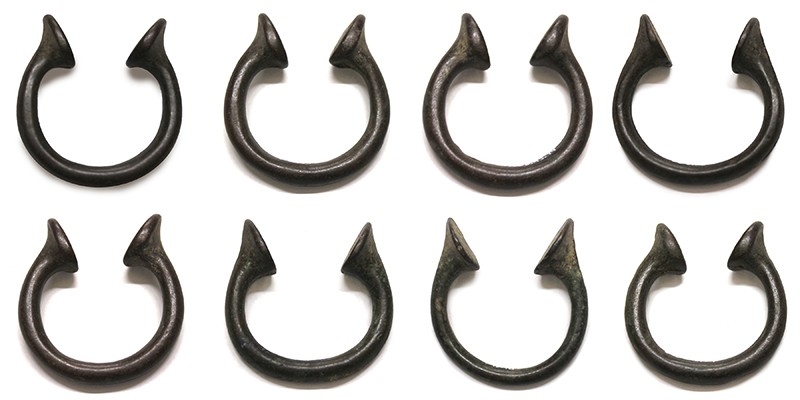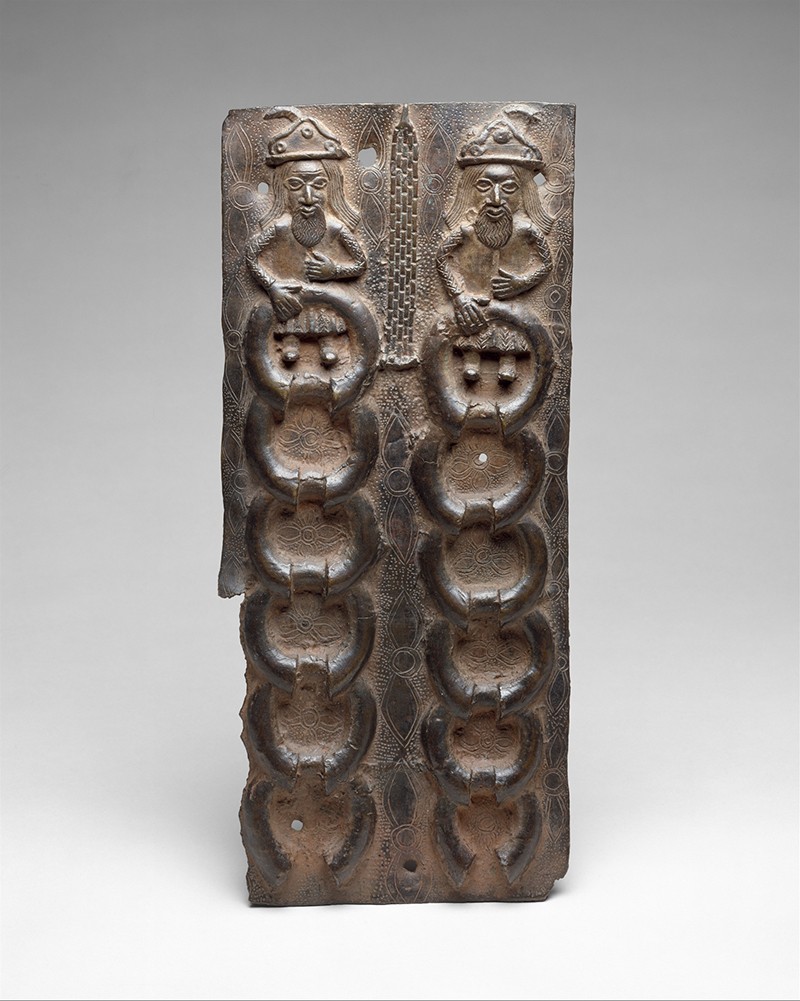 |
Manillas, 19th Century
Unknown Manufacturer; probably Birmingham, England
Leaded brass; Various Dimensions
2003.43.72-.79
Anonymous Gift |
Who wants to be a Manillionaire?
Some might like to make a grand show of wealth, but along the cost of West Africa, one could literally wear their net worth on their sleeve up until the mid 20th Century. At least until inflation hit. The Bowers Blog has previously looked at African non-coin currency forms in Hefty Sum: Central African Throwing Knife Currency. In this post we revisit this topic and examine another African currency, the horseshoe-shaped manilla which was exchanged for trade goods in Nigeria from the 15th Century up until the middle of the 20th Century.
 |
| Bronze plaque from the Kingdom of Benin showing Portuguese traders bringing manillas, made in the 16th or 17th Century. Metropolitan Museum of Art. |
Form and Fund-ction
Like many of the currency forms of Africa, manillas served a dual purpose as an ornament. In this case bracelets or anklets. Copper was first imported into the region through the Sahara Desert to be worn as bracelets up to a millennium ago, but the first instances of manillas in West African culture are recorded on brass plaques from the Kingdom of Benin, which occupied modern-day southern Nigeria up until the turn of the 20th Century. Examples of these brass plaques show manillas being brought to West Africa by the Portuguese, and of the objects being both worn and exchanged for goods. The word ‘manilla’ itself comes from one of several roots, the likeliest being the Spanish word for bracelet. Even if the word originated from Latin or Portuguese, all roots indicate that the purpose of manillas was originally to be worn. As the currency transitioned away from its function as an ornament the appearance of manillas changed as well. By the 20th Century, most manillas would have been either too small or far too large to be worn, and barely recognizable as bracelets.
Slave Money
There is some evidence that manillas were based on a preexisting African design, but the first large influx of the currency came in the mid 15th Century from Portuguese traders who had commissioned them in different cities throughout Europe. The bracelets were in high demand and eagerly traded for West Africa’s major exports: ivory, spices, palm oil, and slaves. Sadly, for much of the history of manillas the business of capturing and enslaving Africans was such standard practice that there were agreed upon exchange rates. Several factors went into these rates, but documents from the 15th Century indicate that only four manillas were required to purchase a slave. Due to the massive influxes of manillas over time—approximately 150,000 each year—there was a depreciation of the currency and by the end of the first quarter of the 16th Century, the price of a slave had already gone up to fifty-seven manillas.
Location of modern day Benin City, the administrative center of the Kingdom of Benin during much of the manilla trade.
Give and Take
The manilla persisted as a currency long after the abolition of slavery in Nigeria, eventually coming to be known for its stability rather than its sullied history. It was not until the beginning of the 20th Century and the imposition of English coinage on Nigeria that there was a push to eliminate the manilla. Despite measures such as outlawing the import of manillas, the currency remained in-use until 1948 when the government of Nigeria began a program of exchanging manillas at an exceptionally good exchange rate. Slightly over 32 million manillas were exchanged for a total sum of £401,135 and melted down. Afterwards legislation was passed making it illegal for individual to have more than 200 manillas in one’s possession. In an interesting twist, the few manillas which survived this trial are now worth more than ever before.
All the Horse’s Shoes
Over their 500 years of use in Nigeria, manillas took a variety of different sizes, compositions, and shapes. The very earliest ones commissioned by the Portuguese were significantly larger than later models, about 3 ½ inches across on average whereas 19th and 20th Century manillas might only be a little over an inch wide. Mineral content also changed greatly over time. There were always outliers—manillas made out of iron being one example—but for the most part early manillas had high copper contents which were replaced over time with brass, and then later as much as 30% lead. Despite the uniformity of the Bowers’ manillas, there was an incredible amount of variation between designs, each of which were independently named and priced. Identification is difficult, because as of yet no reference collection has been discovered, but based on the size, shape and date this is probably an okpoho manilla which was among the most common sizes produced in Birmingham, England in the 19th Century.
Text and images may be under copyright. Please contact Collection Department for permission to use. References are available on request. Information subject to change upon further research.



Comments